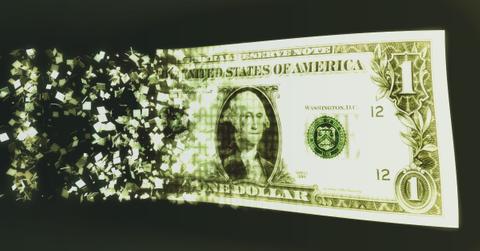Dollar Weakens, Fed Doesn't Plan to End Monetary Stimulus Soon
News that the Federal Reserve doesn’t plan to end its monetary stimulus anytime soon is a reason why the dollar is weakening.
April 20 2021, Published 1:46 p.m. ET

News that the Federal Reserve doesn’t plan to end its monetary stimulus anytime soon is the primary reason why the dollar is weakening, a Commerzbank strategist told CNBC this week.
On April 19, the dollar index fell to 91.156—its lowest level since March 4. Along with the drop in the dollar, the 10-year Treasury yields also were close to the lowest level in five weeks.

The Treasury yield sank to as low as 1.5280 percent last week from an over one-year high of 1.7760 percent at the end of last month. This also reduced the dollar's appeal, Reuters reports.
The drop is the exact opposite of what happened in the first quarter of 2020, when Treasury yields rose and the dollar increased to offer higher returns.
What a weak dollar means for the euro
Meanwhile, things look good for the euro, which was up 0.2 percent at $1.2056. That’s the highest level that the euro has been in about seven weeks.
Analysts point to optimism about increased COVID-19 vaccinations in Europe as the catalyst that pushed up the euro’s value. Recently, the European Union announced that it had secured 100 million additional doses of the BioNTech Pfizer COVID-19 vaccine.
The drop in the dollar prompted analysts at Goldman Sachs to recommend investors turn to the euro, CNBC reports. The company raised its three-month forecast on the euro to $1.25 from $1.21 and other analysts followed suit.
According to CNBC, the IMF says that Europe’s economy is on track to return to its pre-pandemic levels in 2022 with an expected 3.9 percent in growth.

“We think the combination of rising euro area growth expectations, solid equity returns for the region, initial normalization signals from the ECB, and more stable Fed pricing will extend the recent turn higher in the euro,” Goldman analysts wrote in note obtained by CNBC.
Other currencies also saw a boost as the dollar fell.
- The British pound gained 1 percent to over $1.40.
- The Chinese yuan was up 0.4 percent to 6.5031 per dollar.
- The Australian dollar and the New Zealand dollar were up 0.3 percent.
- Against the Japanese yen, the dollar dropped to 108.15, which is the weakest in over six weeks.
Bitcoin also fell to $51,541.16 on April 18, just days after reaching a record high. On April 20, it was back up by 1 percent and trading at around $56,220
Analysts expect the situation to change.
Commerzbank strategist You-Na Park-Heger expects the situation to change rapidly, CNBC reports.
“The economic recovery in the U.S. might drive up inflation expectations further, fueling rate hike speculation. The news situation in the euro zone in connection with corona might change again as uncertainty remains high,” Park-Heger wrote in a note to clients.
Last week, Fed Governor Christopher Waller told CNBC that he predicts an uptrend in the dollar and U.S. yields in the third quarter. The uptick in the dollar will come after Congress approves Biden’s infrastructure plan, the COVID-19 vaccine rollout will be far along, and market speculation about a tapering of federal stimulus will be mounting, according to Waller.
